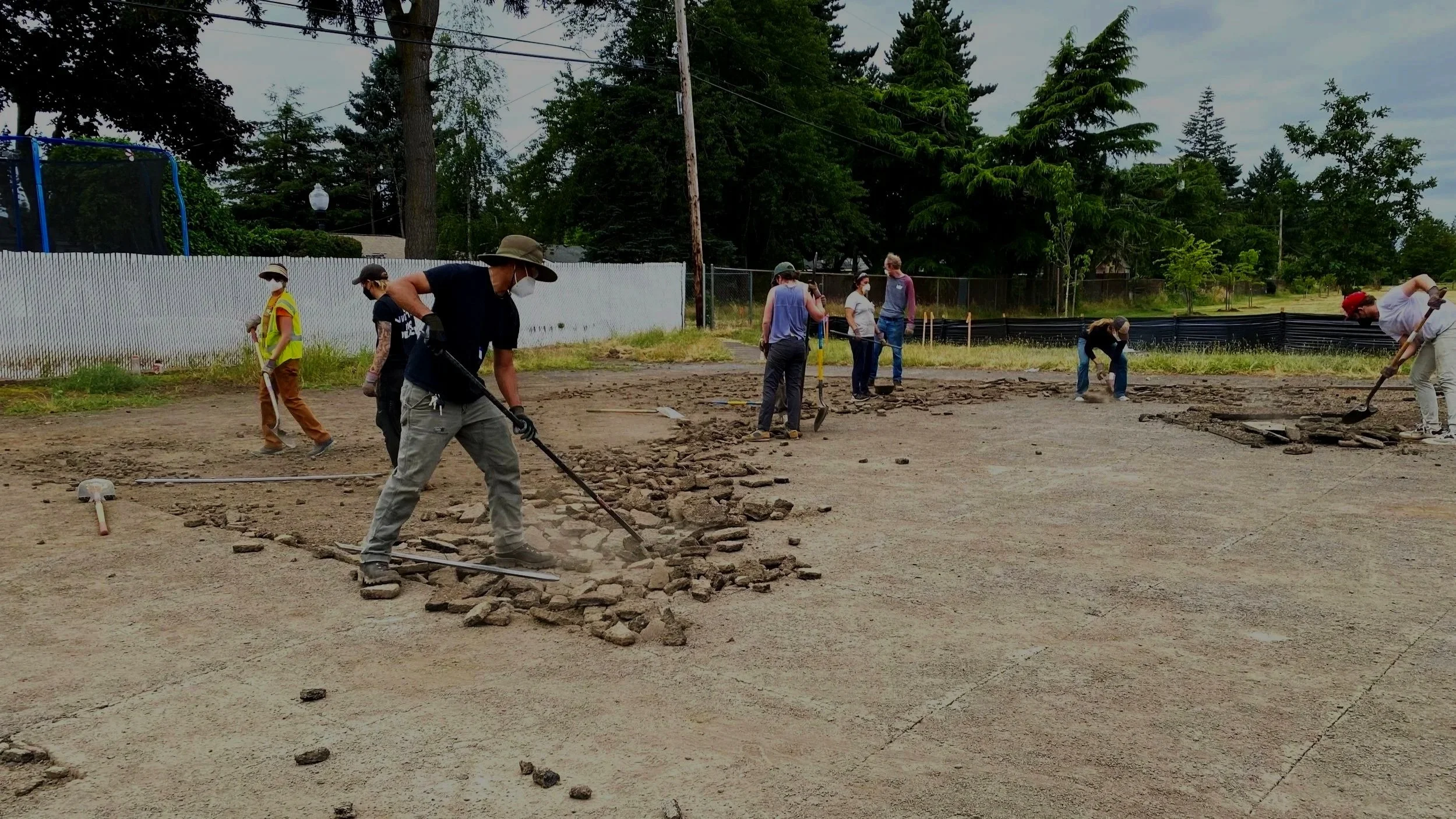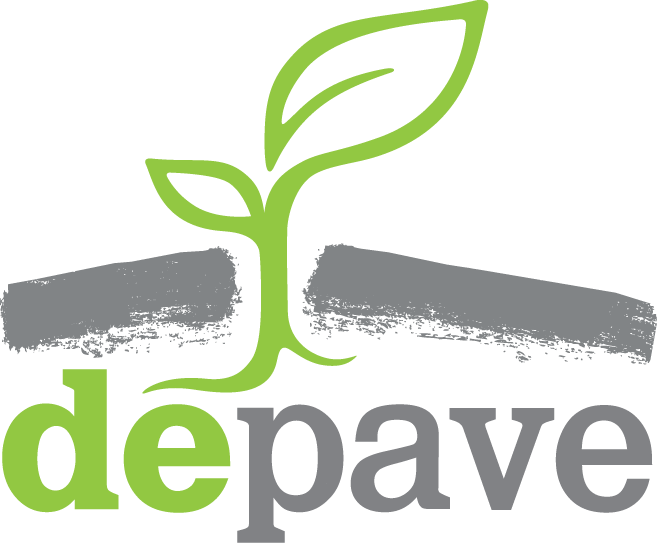
Depaving is Liberation, Collective Action, Future Building.
Why Depave?
To undo decades of unecessary pavement, restore nature through our cities, and create healthier environments for people, we must remove a key barrier: pavement.
Across Chicago, we face big challenges. Urban flooding, extreme heat, dangerous air quality, and a lack of trees, shade, and safe green spaces threaten communities, wildlife, and our rivers and lakes. By strategically removing asphalt, we create space for rain to soak in, trees to grow, children to play, and communities to thrive and adapt to accelerating climate change.
Chicago is not alone. Depave Chicago is part of a growing movement across North America working collaboratively with communities to peel back unnecessary layers of pavement, showing that incremental changes can make big impacts—healthier environments, stronger neighborhoods, and more resilient cities.
SAVE THE DATE
Depave Workshops @ The Montessori School of Englewood - Chicago
June 10-13, 2026
Save the date for a transformative, hands-on depaving & greening project at The Montessori School of Englewood (TMSOE) - a vital hub for West Englewood where children and families learn, grow, and heal from systemic disinvestment. The TMSOE project will bring students, families, neighbors, and greening organizations together to implement a collaborative model of depaving and greening schoolyards to improve children’s health and community well-being. This schoolyard restoration is a cornerstone of climate justice work and an empowering model for other schools.
The TMSOE project will also invite depaving organizations from around the city, region, and country to help undertake the project and to hold education sessions, workshops, on-site training, the depave event days, and a community celebration. Please join us for all or part of the events to learn about and participate in a hands-on model of inter-generational, communal transformation.
Full information and schedule forthcoming!
Why we formed
Following years of exploring the challenges and causes of urban flooding, heat island, air pollution, and inequitable public space and parks, we landed on one simple conclusion : Depaving is a direct solution to climate adapt, support biodiversity, protect public health, create better public space, and drive community empowerment. Depave Chicago provides resources, inspiration, and how-to-guidance on depaving a variety of typical asphalt sites, and collaborates hand-in hand with communities for place-based transformation.
In our work, we commit to:
RELATIONSHIP BUILDING. We commit to initiating projects and partnerships in ways that honor and create genuine reciprocity. Through deep listening we aim to build trust and create processes for everyone to participate fully from the very beginning.
COLLECTIVE PROCESS. Together with partners, we cultivate shared knowledge, resources, and capacity. We continuously learn and refine our approaches, and embrace transparent and iterative ways of working together.
TRANSFORMATIVE PURPOSE. We design and implement community-based projects that reimagine and vitalize community health, public space, and urban land. These transformations accrue over time and we hope they inspire others to take action.
LAND AS OUR MEDIUM. Our work is rooted in care for the land, honoring local knowledge, regenerative design, and reconnecting people with nature. We emphasize a dedication to the land and care for communities through attention to place.
THE LONG-TERM. We are dedicated to creative and careful planning to sustain this transformative work together long into the future. We navigate challenges together, adapt as needed, and celebrate successes together.
Donate & Support
SUPPORT OUR PILOT PROJECT!
We’re seeking funding to support the implementation of our pilot depave project at The Montessori School of Englewood. Your donations will help pay for implementation and construction of the project, workshops, volunteer support, and education programming! Thank you in advance!
To become a direct supporter or partner of Depave Chicago, please contact Mary Pat McGuire at mpm1@illinois.edu.
DEPAVE CHICAGO PARTNERS & SUPPORTERS
The start-up of Depave Chicago is funded by a Resilient x Nature Grant from the Walder Foundation. Depave Chicago is founded and managed by University of Illinois Water Lab, headed by Associate Professor Mary Pat McGuire, and affiliated with the Department of Landscape Architecture, UIUC. Our location in the downtown Chicago Studio is generously provided by the College of Fine & Applied Arts, UIUC.
SPECIAL THANKS!…..
Depave Chicago is guided by the amazing Katya Reyna and Ted Labbe of Depave (Portland) whose mentoring and teaching not only lay the groundwork for our program but fuel our ethos and passion for this work. Katya and Ted, thank you!
We’re grateful for support and advice from the following organizations and agencies:
Chicago Region Trees Initiative, Environmental Law & Policy Center, Greater Chicago Watershed Alliance, Members of the Chicago Calumet Stormwater Collective, Metropolitan Water Reclamation District, Neighbors for Environmental Justice, Openlands, Trust for Public Land, US Forest Service, Nordson Green Earth Initiative, Red Oak Rain Garden (University of Illinois), Farnsworth Group, Urban Rivers
Land Acknowledgement
Depave Chicago, located in Chicago, Illinois, sits on the unceded lands of the Council of Three Fires, the Odawa, Ojibwe, and Potawatomi Nations, as well as the tribes of the Miami, Ho-Chunk, Menominee, Sac, Fox, Kickapoo, and Illinois Nations. Controlled occupation of these lands through land cessions and forced removal of Indigenous people occurred through the Treaty of Greenville (1795), the Treaty of St. Louis (1816), and the Indian Removal Act (1830). The histories of Indigenous peoples and all communities throughout the Chicago region must be acknowledged in the work of Depave Chicago. We must honor and celebrate traditions and care for the land and the waters of the region. And we must contribute to the work of restoring relationships among land, water, people, and all living species and entities of the region for remaining Indigenous communities and for all people who live here.




